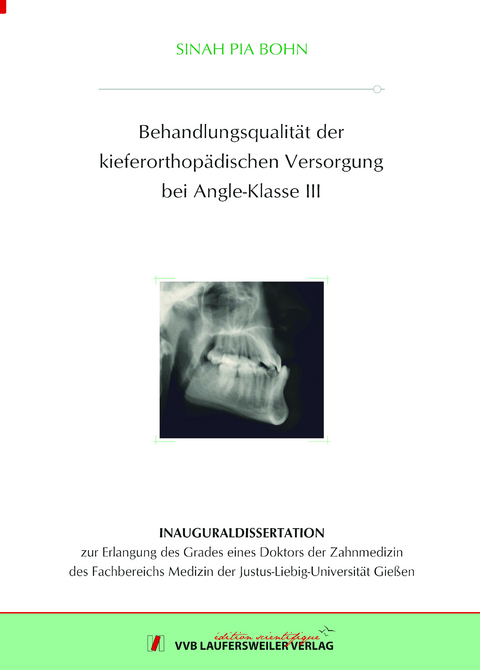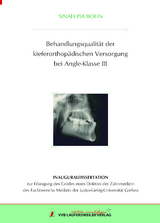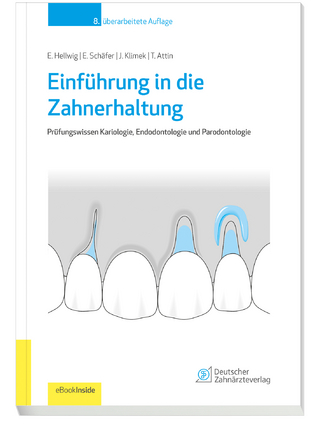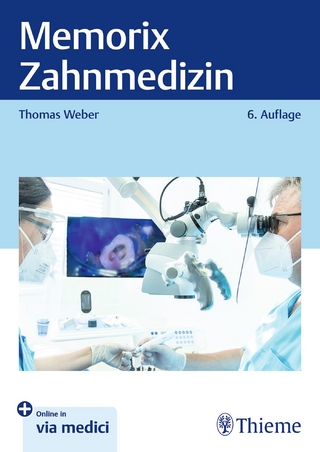Behandlungsqualität der kieferorthopädischen Versorgung bei Angle-Klasse III
Seiten
2023
VVB Laufersweiler Verlag
978-3-8359-7138-7 (ISBN)
VVB Laufersweiler Verlag
978-3-8359-7138-7 (ISBN)
- Keine Verlagsinformationen verfügbar
- Artikel merken
Das Ziel der vorliegenden Studie war die Beurteilung der Behandlungsqualität der kieferorthopädischen Versorgung aller Angle-Klasse III Patienten in der Poliklinik für Kieferorthopädie der Justus-Liebig-Universität Gießen im Erhebungszeitraum von 1990-2020, unabhängig davon, ob es sich um eine Früh- oder eine Hauptbehandlung handelte. Als Hauptzielparameter dienten der PAR-Index (RICHMOND et al. 1992a; 1992b) und die Beurteilung nach AHLGREN (1988). Als Nebenzielparameter wurden Habits und Funktionsstörungen, das Vorliegen kongenitaler Anomalien sowie Retentionen und/oder Nichtanlagen bei Behandlungsbeginn erfasst. Weiter wurden die Veränderungen okklusaler Variablen, das Auftreten von Rezessionen sowie die Anzahl der im frontalen Kreuzbiss stehenden Zähne berücksichtigt. Die Daten wurden für die Frühbehandlung, die Hauptbehandlung inklusive Retention oder aber für die erfolgte Früh- und Hauptbehandlung einschließlich der Retention erhoben.
Die Einschlusskriterien umfassten:
-Angle-Klasse III
-Frühbehandlung, Hauptbehandlung oder beides
-abgeschlossene Behandlung bis Ende 2020
Eingeschlossen werden konnten 42 Patienten für die Frühbehandlung und 148 Patienten für die Hauptbehandlung, darunter 17 Patienten, die sowohl eine Früh- als auch eine Hauptbehandlung am Studienzentrum erhielten.
Bezogen auf die Behandlungsqualität konnten folgende Ergebnisse abgeleitet werden:
-Frühbehandlung: der initiale PAR-Wert von 32,6 ± 7,5 Punkten konnte um 15,0 ± 13,0 Punkte auf 17,5 ± 10 Punkte reduziert werden.
-nach der Frühbehandlung erreichten 31% die Kategorie „greatly improved“, 43% „improved“ und 26% die Kategorie „worse/no different“.
-Hauptbehandlung: der initiale PAR-Wert von 35,2 ± 9,5 Punkten konnte um 29,3 ± 10,8 Punkte auf 6,0 ± 5,0 Punkte (T1) reduziert und in der Nachbeobachtungsphase (T2) weitestgehend stabil bei 6,7 ± 5,2 Punkten gehalten werden.
-nach der aktiven Hauptbehandlung erreichten 71% die Kategorie „greatly improved“, 23% „improved“ und 6% die Kategorie „worse/no different“. Nach der Retention verteilten sich die Patienten mit 69% auf die Kategorie „greatly improved“, 23% auf „improved“ und 8% auf „worse/no different“.
-Die nur zum Zeitpunkt T2 stattfindende Bewertung nach AHLGREN (1988) beurteilte 11% als ausgezeichnetes, 34% als gutes, 41% als akzeptables und 14% als inakzeptables Behandlungsergebnis.
-Unter der Frühbehandlung (T0*-T1*) konnte die Anzahl der Patienten mit Zähnen im frontalen Kreuzbiss um 64%, während der Hauptbehandlung (T0-T2) um 76% reduziert werden.
-Während der Frühbehandlung (T0*-T1*) konnte die Okklusion im Molarenbereich im Median rechts um ¼ Pb auf Neutralokklusion verbessert werden, während es links zu einer Verschlechterung um ¼ Pb auf ½ Pb Mesialokklusion kam. Während der Hauptbehandlung (T0-T2) konnte der Median der Molarenokklusion von ½ Pb mesial beidseits auf eine Neutralokklusion verbessert werden.
-Es konnte ein moderater Zusammenhang der Variablen ANB (r= 0,550) und ML/NSL (r= 0,506) für die PAR-Wert Reduktion während der Frühbehandlung und bei den Variablen Overjet zum Zeitpunkt T0 (ρ= -0,562) und der Anzahl der Zähne im frontalen Kreuzbiss zum Zeitpunkt T0 (ρ= 0,667) für die PAR-Wert Reduktion während der Hauptbehandlung ermittelt werden.
-Rezessionen wurden nur während der Hauptbehandlung untersucht; zu T0 hatten 15% der Patienten Rezessionen, unter der Behandlung stieg die Anzahl zu T1 auf 48% und zu T2 nochmals auf 53% an. Am häufigsten betroffen waren die Unterkieferfrontzähne 31 und 41.
Die Frühbehandlung kann effektiv dazu dienen, frontale Kreuzbisse zu überstellen und somit den Weg für eine normale Gebissentwicklung zu bahnen. Die PAR-Wert Reduktion und auch die Okklusion müssen hier aufgrund der gegebenen kassenrechtlichen Limitationen weniger streng bewertet werden.
Im Rahmen der Hauptbehandlung sollte laut RICHMOND et al. (1992b) die prozentuale Verteilung in der Kategorie „worse/no different“ ≤5% sein (hier 6%/8%) und die durchschnittliche PAR-Index Verbesserung ≥70% (hier 80%/77%) betragen. Somit kann die Behandlungsqualität der kieferorthopädischen Versorgung der Angle-Klasse III während der Hauptbehandlung am Studienzentrum als gut bewertet werden.
Eindeutige prädiktive Faktoren für ein gutes oder schlechtes Behandlungsresultat konnten nicht identifiziert werden. The aim of the present study was to assess the quality of treatment of all Angle-Class III patients at the Department of Orthodontics of the Justus Liebig University Giessen during the survey period 1990-2020, regardless of whether they received early or main treatment. The PAR index (RICHMOND et al. 1992b; RICHMOND et al. 1992a) and the assessment according to AHLGREN (1988) served as main target parameters. Secondary outcome measures were habits and dysfunction, congenital anomalies, and retention and/or agenesis of teeth at baseline. Furthermore, the changes in occlusal variables, the occurrence of recessions, and the number of teeth in frontal crossbite were considered. Data were collected for early treatment, main treatment including retention, or both, early and main treatment including retention.
Inclusion criteria contained:
-Angle class III
-Early treatment, main treatment or both
-Treatment completed by the end of 2020
The study included 43 patients with early treatment and 148 patients with main treatment, including 17 patients who received both early and main treatment at the study center.
With regard to treatment quality, the following results could be derived:
-Early treatment: the initial PAR score of 32.6 ± 7.5 points was reduced by 15.0 ± 13.0 points to 17.5 ± 10 points.
-After early treatment, 31% achieved the category "greatly improved", 43% "improved" and 26% the category "worse/no different".
-Main treatment: the initial PAR score of 35.2 ± 9.5 points was reduced by 29.3 ± 10.8 points to 6.0 ± 5.0 points (T1) and remained largely stable at 6.7 ± 5.2 points in the follow-up phase (T2).
-After the active main treatment, 71% achieved the category "greatly im-proved", 23% "improved" and 6% the category "worse/no different". After retention, 69% of the patients were in the "greatly improved" category, 23% in the "improved" category and 8% in the "worse/no different" category.
-The AHLGREN (1988) evaluation, which only took place at T2, rated 11% as excellent, 34% as good, 41% as acceptable, and 14% as unacceptable treatment results.
-The number of patients with frontal crossbite teeth was reduced by 64% during early treatment (T0*-T1*) and by 76% during main treatment (T0-T2).
-During early treatment (T0*-T1*), the median occlusion in the molar region improved by ¼ Pb to neutral occlusion on the right side, while it deteriorated by ¼ Pb to ½ Pb mesial occlusion on the left side. During the main treatment (T0-T2), the median molar occlusion improved from ½ Pb mesial to neutral occlusion on both sides.
-A moderate correlation of the variables ANB (r= 0.550) and ML/NSL (r= 0.506) for the PAR reduction during early treatment and for the variables overjet at T0 (ρ= -0.562) and the number of teeth in the frontal crossbite at T0 (ρ= 0.667) for the PAR reduction during main treatment could be determined.
-Recessions were only investigated during the main treatment; at T0, 15% of the patients had recessions, under treatment the number increased to 48% at T1 and again to 53% at T2. The most frequently affected teeth were the mandibular anterior teeth 31 and 41.
Early treatment can effectively serve to correct frontal crossbites and thus pave the way for normal dentition development. The PAR score reduction and also the occlusion must be evaluated less strictly due to the given limits under health insurance law.
According to RICHMOND et al. (1992b), the percentage distribution during main treatment in the "worse/no different" category should be ≤5% (here 6%/8%) and the average PAR index improvement should be ≥70% (here 80%/77%). Thus, the treatment quality of Angle-Class III orthodontic care during the main treatment at the study center can be rated as good.
Clearly predisposing factors for good or poor treatment quality outcome could not be identified.
Die Einschlusskriterien umfassten:
-Angle-Klasse III
-Frühbehandlung, Hauptbehandlung oder beides
-abgeschlossene Behandlung bis Ende 2020
Eingeschlossen werden konnten 42 Patienten für die Frühbehandlung und 148 Patienten für die Hauptbehandlung, darunter 17 Patienten, die sowohl eine Früh- als auch eine Hauptbehandlung am Studienzentrum erhielten.
Bezogen auf die Behandlungsqualität konnten folgende Ergebnisse abgeleitet werden:
-Frühbehandlung: der initiale PAR-Wert von 32,6 ± 7,5 Punkten konnte um 15,0 ± 13,0 Punkte auf 17,5 ± 10 Punkte reduziert werden.
-nach der Frühbehandlung erreichten 31% die Kategorie „greatly improved“, 43% „improved“ und 26% die Kategorie „worse/no different“.
-Hauptbehandlung: der initiale PAR-Wert von 35,2 ± 9,5 Punkten konnte um 29,3 ± 10,8 Punkte auf 6,0 ± 5,0 Punkte (T1) reduziert und in der Nachbeobachtungsphase (T2) weitestgehend stabil bei 6,7 ± 5,2 Punkten gehalten werden.
-nach der aktiven Hauptbehandlung erreichten 71% die Kategorie „greatly improved“, 23% „improved“ und 6% die Kategorie „worse/no different“. Nach der Retention verteilten sich die Patienten mit 69% auf die Kategorie „greatly improved“, 23% auf „improved“ und 8% auf „worse/no different“.
-Die nur zum Zeitpunkt T2 stattfindende Bewertung nach AHLGREN (1988) beurteilte 11% als ausgezeichnetes, 34% als gutes, 41% als akzeptables und 14% als inakzeptables Behandlungsergebnis.
-Unter der Frühbehandlung (T0*-T1*) konnte die Anzahl der Patienten mit Zähnen im frontalen Kreuzbiss um 64%, während der Hauptbehandlung (T0-T2) um 76% reduziert werden.
-Während der Frühbehandlung (T0*-T1*) konnte die Okklusion im Molarenbereich im Median rechts um ¼ Pb auf Neutralokklusion verbessert werden, während es links zu einer Verschlechterung um ¼ Pb auf ½ Pb Mesialokklusion kam. Während der Hauptbehandlung (T0-T2) konnte der Median der Molarenokklusion von ½ Pb mesial beidseits auf eine Neutralokklusion verbessert werden.
-Es konnte ein moderater Zusammenhang der Variablen ANB (r= 0,550) und ML/NSL (r= 0,506) für die PAR-Wert Reduktion während der Frühbehandlung und bei den Variablen Overjet zum Zeitpunkt T0 (ρ= -0,562) und der Anzahl der Zähne im frontalen Kreuzbiss zum Zeitpunkt T0 (ρ= 0,667) für die PAR-Wert Reduktion während der Hauptbehandlung ermittelt werden.
-Rezessionen wurden nur während der Hauptbehandlung untersucht; zu T0 hatten 15% der Patienten Rezessionen, unter der Behandlung stieg die Anzahl zu T1 auf 48% und zu T2 nochmals auf 53% an. Am häufigsten betroffen waren die Unterkieferfrontzähne 31 und 41.
Die Frühbehandlung kann effektiv dazu dienen, frontale Kreuzbisse zu überstellen und somit den Weg für eine normale Gebissentwicklung zu bahnen. Die PAR-Wert Reduktion und auch die Okklusion müssen hier aufgrund der gegebenen kassenrechtlichen Limitationen weniger streng bewertet werden.
Im Rahmen der Hauptbehandlung sollte laut RICHMOND et al. (1992b) die prozentuale Verteilung in der Kategorie „worse/no different“ ≤5% sein (hier 6%/8%) und die durchschnittliche PAR-Index Verbesserung ≥70% (hier 80%/77%) betragen. Somit kann die Behandlungsqualität der kieferorthopädischen Versorgung der Angle-Klasse III während der Hauptbehandlung am Studienzentrum als gut bewertet werden.
Eindeutige prädiktive Faktoren für ein gutes oder schlechtes Behandlungsresultat konnten nicht identifiziert werden. The aim of the present study was to assess the quality of treatment of all Angle-Class III patients at the Department of Orthodontics of the Justus Liebig University Giessen during the survey period 1990-2020, regardless of whether they received early or main treatment. The PAR index (RICHMOND et al. 1992b; RICHMOND et al. 1992a) and the assessment according to AHLGREN (1988) served as main target parameters. Secondary outcome measures were habits and dysfunction, congenital anomalies, and retention and/or agenesis of teeth at baseline. Furthermore, the changes in occlusal variables, the occurrence of recessions, and the number of teeth in frontal crossbite were considered. Data were collected for early treatment, main treatment including retention, or both, early and main treatment including retention.
Inclusion criteria contained:
-Angle class III
-Early treatment, main treatment or both
-Treatment completed by the end of 2020
The study included 43 patients with early treatment and 148 patients with main treatment, including 17 patients who received both early and main treatment at the study center.
With regard to treatment quality, the following results could be derived:
-Early treatment: the initial PAR score of 32.6 ± 7.5 points was reduced by 15.0 ± 13.0 points to 17.5 ± 10 points.
-After early treatment, 31% achieved the category "greatly improved", 43% "improved" and 26% the category "worse/no different".
-Main treatment: the initial PAR score of 35.2 ± 9.5 points was reduced by 29.3 ± 10.8 points to 6.0 ± 5.0 points (T1) and remained largely stable at 6.7 ± 5.2 points in the follow-up phase (T2).
-After the active main treatment, 71% achieved the category "greatly im-proved", 23% "improved" and 6% the category "worse/no different". After retention, 69% of the patients were in the "greatly improved" category, 23% in the "improved" category and 8% in the "worse/no different" category.
-The AHLGREN (1988) evaluation, which only took place at T2, rated 11% as excellent, 34% as good, 41% as acceptable, and 14% as unacceptable treatment results.
-The number of patients with frontal crossbite teeth was reduced by 64% during early treatment (T0*-T1*) and by 76% during main treatment (T0-T2).
-During early treatment (T0*-T1*), the median occlusion in the molar region improved by ¼ Pb to neutral occlusion on the right side, while it deteriorated by ¼ Pb to ½ Pb mesial occlusion on the left side. During the main treatment (T0-T2), the median molar occlusion improved from ½ Pb mesial to neutral occlusion on both sides.
-A moderate correlation of the variables ANB (r= 0.550) and ML/NSL (r= 0.506) for the PAR reduction during early treatment and for the variables overjet at T0 (ρ= -0.562) and the number of teeth in the frontal crossbite at T0 (ρ= 0.667) for the PAR reduction during main treatment could be determined.
-Recessions were only investigated during the main treatment; at T0, 15% of the patients had recessions, under treatment the number increased to 48% at T1 and again to 53% at T2. The most frequently affected teeth were the mandibular anterior teeth 31 and 41.
Early treatment can effectively serve to correct frontal crossbites and thus pave the way for normal dentition development. The PAR score reduction and also the occlusion must be evaluated less strictly due to the given limits under health insurance law.
According to RICHMOND et al. (1992b), the percentage distribution during main treatment in the "worse/no different" category should be ≤5% (here 6%/8%) and the average PAR index improvement should be ≥70% (here 80%/77%). Thus, the treatment quality of Angle-Class III orthodontic care during the main treatment at the study center can be rated as good.
Clearly predisposing factors for good or poor treatment quality outcome could not be identified.
| Erscheinungsdatum | 11.08.2023 |
|---|---|
| Reihe/Serie | Edition Scientifique |
| Verlagsort | Gießen |
| Sprache | deutsch |
| Maße | 148 x 215 mm |
| Gewicht | 330 g |
| Themenwelt | Medizin / Pharmazie ► Zahnmedizin ► Klinik und Praxis |
| Schlagworte | Edward Angle • ideale Zahnbogenform • Neutralbiss • Ober- und Unterkiefer • Vorbiss • Zahnfehlstellung • Zahn- und Kieferfehlstellungen |
| ISBN-10 | 3-8359-7138-7 / 3835971387 |
| ISBN-13 | 978-3-8359-7138-7 / 9783835971387 |
| Zustand | Neuware |
| Haben Sie eine Frage zum Produkt? |
Mehr entdecken
aus dem Bereich
aus dem Bereich
Prüfungswissen Kariologie, Endodontologie und Parodontologie
Buch (2023)
Deutscher Ärzteverlag
69,99 €




